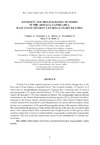Please use this identifier to cite or link to this item:
https://accedacris.ulpgc.es/jspui/handle/10553/23007
| Title: | Diversity and biogeography of fishes in the Arinaga-Gando area, east coast of Gran Canaria (Canary Island) | Authors: | Espino Rodríguez, Fernando González Pérez, José Antonio Boyra, Arturo Fernández, C. Tuya, F. Brito Hernández, Alberto Miguel |
UNESCO Clasification: | 251005 Zoología marina 251092 Acuicultura marina 240114-4 Taxonomía animal. Peces |
Keywords: | Ichthyofauna Biodiversity Marine protected area Zoogeografía Islas Canarias |
Issue Date: | 2014 | Journal: | Revista de la Academia Canaria de Ciencias | Abstract: | A check-list of fishes regularly present in waters of the Gando-Arinaga area, in the East coast of Gran Canaria, is presented herein. This inventory includes 175 species, 22 of which were of chondrichthyans (belonging to 19 genera and 13 families), and 153 were of actinopterygiians (121 genera and 60 families), 77.15% of the species have stable populations in the area and 61.15% have commercial interest. The zoogeographic analysis showed a dominance of the Atlantic-Mediterranean distribution species (26%), followed by the Warmtemperate in the Eastern Atlantic distribution species (16%), while Eastern Central Atlantic Oceanic Islands (9%), Guinean (8%) and Macaronesian (4%) species showed smaller values, but they were representative of the general biogeographic pattern of the canarian ichthyofauna. El inventario de la ictiofauna del sector costero Gando-Arinaga, en el litoral Este de la isla de Gran Canaria, incluye 175 especies, 22 especies de condrictios (agrupados en 19 géneros y 13 familias) y 153 de actinopterigios (121 géneros y 60 familias); el 77,15% de las especies presentan poblaciones estables en la zona y un 61,15% de las especies tienen interés comercial. El análisis zoogeográfico mostró un predomino de las especies de distribución Atlántico-Mediterránea (26%), seguidas por las especies de distribución en áreas Cálido-templadas del Atlántico Oriental (16%), mientras que las especies de las Islas Oceánicas del Atlántico Centroriental (9%), Guineanas (8%) y Macaronésicas (4%) mostraron valores menores, pero representativos del patrón biogeográfico general de la ictiofauna canaria. |
URI: | https://accedacris.ulpgc.es/handle/10553/23007 | ISSN: | 1130-4723 | Source: | Revista de la Academia Canaria de Ciencias [ISSN 1130-4723], v. 26 (1), p. 9-25 | Rights: | by-nc-nd | URL: | http://dialnet.unirioja.es/servlet/articulo?codigo=5909114 |
| Appears in Collections: | Artículos |
Page view(s)
160
checked on Nov 16, 2024
Download(s)
92
checked on Nov 16, 2024
Google ScholarTM
Check
Share
Export metadata
Items in accedaCRIS are protected by copyright, with all rights reserved, unless otherwise indicated.
